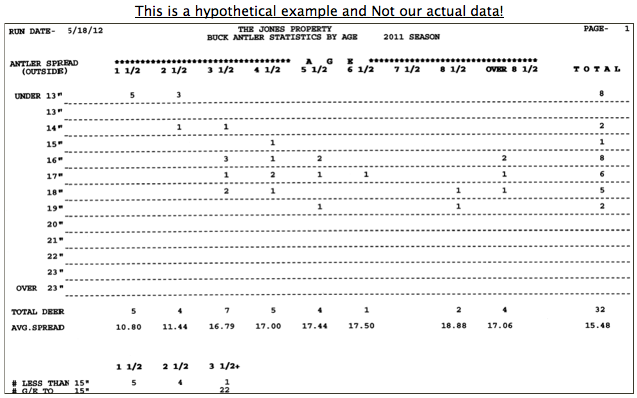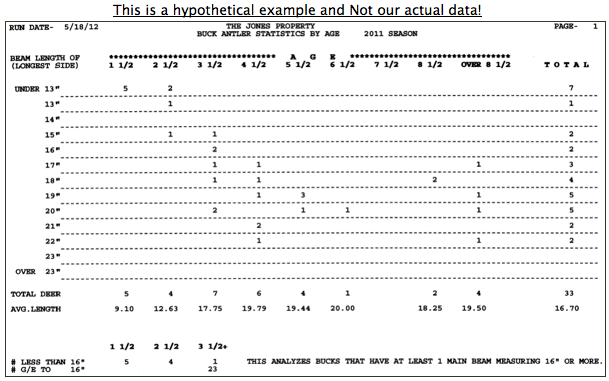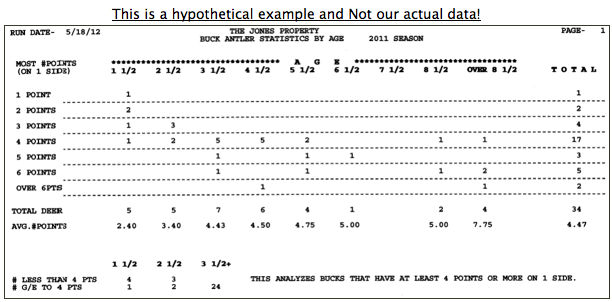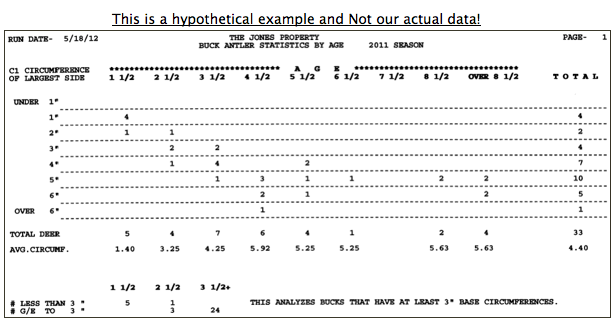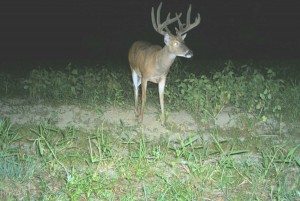 I want to review how to analyze the antler characteristics of your Buck population for the possible implementation of antler restrictions. There are some states, counties, townships and large private properties that currently have antler restrictions in place. The purpose of these restrictions is to protect yearling (1 ½ year old) and possibly some 2 ½ year old Bucks. Even though the best way to age a Buck is by his body characteristics most people are unable to do that. If you have not done so already please watch my video “How to age a Buck on the Hoof”. If your hunters are unable to age a Buck on the hoof then the next best thing to do is to see if you can come up with an antler characteristic that will protect most of your 1 ½ year old Bucks and possibly some or all of your 2 ½ year old Bucks. I can’t emphasize enough how important it is to do a thorough study of the property that you wish to implement a restriction in. If you wish to implement a restriction for an entire state then you have to gather data from throughout the entire state. If you wish to implement a restriction for an entire county or township then you have to gather data from throughout the entire county or township. If it is your private property that you wish to implement a restriction in then you must gather data from throughout your entire property. This study should be done for at least 2 or 3 seasons. If you have a year with drought conditions then the antler growth could be stunted in which case you shouldn’t establish your restriction when the antlers aren’t at normal growth. If you are actually implementing the restriction on your own private property then at least you have the option of changing your restriction for the drought year if you deem it necessary. States and counties don’t have the luxury of changing their law for one year. I believe you will find that antler restrictions can work in many places. It is possible that you may establish one single criteria for your restriction or possibly two criteria of which the antlers only need to meet one of the criteria specified. Because of the varying antler characteristics and size from state to state, county to county and even possibly within a county itself they each have to come up with their own antler restriction based on their own individual study. For example you may determine that a 15” outside spread would protect most of your yearling Bucks and only some of your 2 ½ year old Bucks. You may find this acceptable for what you are trying to do. On another property they may determine that a 17” outside spread would protect most of their yearling Bucks and some or all of their 2 ½ year old Bucks. Another property may determine that an 18” main beam would protect most of their yearling Bucks and some of their 2 ½ year old Bucks. I know that some places also use a 4 point on one side regulation that requires that the Buck have at least 4 points on one side to make him legal to shoot. It is possible that you may have to have something like a 15” outside spread OR a 16” main beam rule which means that if the Buck has either of the characteristics then he is ok to shoot. You must be careful that the restriction that you come up with does not protect any older Bucks. There can always be that one exception but if you inadvertently protect some Bucks for their entire life then you could be causing yourself some problems. In our situation a spread regulation will not work. We definitely have some Bucks that will never have a 15” outside spread. Also somewhere between 20% and 40% of our yearling Bucks have 4 points on one side so we don’t like the fact that this regulation would actually legalize between 20% and 40% of our yearling Bucks. From my studies of our own Bucks a 16” main beam would protect most all (if not all) of our yearling Bucks and only some of our 2 ½ year old Bucks. On the other hand it will legalize all of our 3 ½ year old and older Bucks. Please understand that this just means that the hunter can make his or her own decision on whether to shoot these 3 ½ year old and older Bucks and not have a regulation dictate that they can’t shoot them. Just imagine what may happen if you inadvertently protect 10% to 20% of your Bucks for their entire life!
I want to review how to analyze the antler characteristics of your Buck population for the possible implementation of antler restrictions. There are some states, counties, townships and large private properties that currently have antler restrictions in place. The purpose of these restrictions is to protect yearling (1 ½ year old) and possibly some 2 ½ year old Bucks. Even though the best way to age a Buck is by his body characteristics most people are unable to do that. If you have not done so already please watch my video “How to age a Buck on the Hoof”. If your hunters are unable to age a Buck on the hoof then the next best thing to do is to see if you can come up with an antler characteristic that will protect most of your 1 ½ year old Bucks and possibly some or all of your 2 ½ year old Bucks. I can’t emphasize enough how important it is to do a thorough study of the property that you wish to implement a restriction in. If you wish to implement a restriction for an entire state then you have to gather data from throughout the entire state. If you wish to implement a restriction for an entire county or township then you have to gather data from throughout the entire county or township. If it is your private property that you wish to implement a restriction in then you must gather data from throughout your entire property. This study should be done for at least 2 or 3 seasons. If you have a year with drought conditions then the antler growth could be stunted in which case you shouldn’t establish your restriction when the antlers aren’t at normal growth. If you are actually implementing the restriction on your own private property then at least you have the option of changing your restriction for the drought year if you deem it necessary. States and counties don’t have the luxury of changing their law for one year. I believe you will find that antler restrictions can work in many places. It is possible that you may establish one single criteria for your restriction or possibly two criteria of which the antlers only need to meet one of the criteria specified. Because of the varying antler characteristics and size from state to state, county to county and even possibly within a county itself they each have to come up with their own antler restriction based on their own individual study. For example you may determine that a 15” outside spread would protect most of your yearling Bucks and only some of your 2 ½ year old Bucks. You may find this acceptable for what you are trying to do. On another property they may determine that a 17” outside spread would protect most of their yearling Bucks and some or all of their 2 ½ year old Bucks. Another property may determine that an 18” main beam would protect most of their yearling Bucks and some of their 2 ½ year old Bucks. I know that some places also use a 4 point on one side regulation that requires that the Buck have at least 4 points on one side to make him legal to shoot. It is possible that you may have to have something like a 15” outside spread OR a 16” main beam rule which means that if the Buck has either of the characteristics then he is ok to shoot. You must be careful that the restriction that you come up with does not protect any older Bucks. There can always be that one exception but if you inadvertently protect some Bucks for their entire life then you could be causing yourself some problems. In our situation a spread regulation will not work. We definitely have some Bucks that will never have a 15” outside spread. Also somewhere between 20% and 40% of our yearling Bucks have 4 points on one side so we don’t like the fact that this regulation would actually legalize between 20% and 40% of our yearling Bucks. From my studies of our own Bucks a 16” main beam would protect most all (if not all) of our yearling Bucks and only some of our 2 ½ year old Bucks. On the other hand it will legalize all of our 3 ½ year old and older Bucks. Please understand that this just means that the hunter can make his or her own decision on whether to shoot these 3 ½ year old and older Bucks and not have a regulation dictate that they can’t shoot them. Just imagine what may happen if you inadvertently protect 10% to 20% of your Bucks for their entire life!
I will now show you samples of the reports that you can get if you key in the antler measurements through the advanced version of our software. The six different measurements that we will analyze are outside spread, inside spread, beam length of the longest side, number of points on one side, base circumference of largest side and B&C Gross. The samples below are strictly hypothetical. They are not our own statistical reports. I put them together so I could explain what they mean. The samples below are only for one season as well, whereas you will need to analyze multiple seasons and have a large enough sampling to be able to come to a valid conclusion.
This first report above analyzes the outside spread. You can run it for one season or for multiple seasons. I break down the age categories from 1 ½ to over 8 ½. If the Buck has an outside spread of 14.75” then he is included on the line that says 14”. At the bottom I show the total number of deer that were analyzed in each age group along with the average spread for that age group. I also show an analysis that will allow you to determine if the restriction you are considering will protect many 3 ½ year old and older Bucks. When I ran the report I indicated that I wanted to analyze a 15” outside spread. As a result of that I can see that in the Bucks that were harvested that all five yearlings had an outside spread less than 15”, all four 2 ½ year old Bucks had an outside spread of less than 15” but only one 3 ½ year old and older Bucks had an outside spread less than 15”. If I felt certain that this was a good sampling of our Buck population then I would feel confident that a 15” outside spread requirement would protect most all of our yearling Bucks and 2 ½ year old Bucks. It would however legalize all of the 3 ½ year old and older Bucks (with one exception) which would work great in many management programs. If you have wider antler characteristics in your Bucks then you may specify 17” or more for your special analysis at the bottom. I won’t bother showing the analysis for inside spread since it looks similar to the above except that it is using the inside spread instead of the outside spread.
The next report above analyzes the beam length of the longest side. You can run it for one season or for multiple seasons. I break down the age categories from 1 ½ to over 8 ½. If the Buck
has a beam length of 14.75” then he is included on the line that says 14”. At the bottom I show the total number of deer that were analyzed in each age group along with the average longest beam length for that age group. I also show an analysis that will allow you to determine if the restriction you are considering will protect many 3 ½ year old and older Bucks. When I ran the report I indicated that I wanted to analyze a 16” main beam. As a result of that I can see that in the Bucks that were harvested that all five yearlings had main beams less than 16”, all four 2 ½ year old Bucks had main beams less than 16” but only one 3 ½ year old and older Bucks had main beams less than 16”. If I felt certain that this was a good sampling of our Buck population then I would feel confident that a 16” main beam requirement would protect most all of our yearling Bucks and 2 ½ year old Bucks. It would however legalize all of the 3 ½ year old and older Bucks (with one exception) which would work great in many management programs. If you have longer beam characteristics in your Bucks then you may specify 18” or more for your special analysis at the bottom. If you happened to notice that I analyzed 32 Bucks on the first report and now 33 Bucks on this report you made a good observation. There was one Buck that only had one side of their antlers so I didn’t key any spread measurements but I did key a beam length.
The next report above analyzes the number of points on one side. You can run it for one season or for multiple seasons. I use the side with the most number of points so if there are three points on the left side and four points on the right side then I count the Buck as having four points on one side. I break down the age categories from 1 ½ to over 8 ½. If the Buck has 4 points on one side then he is included on the line that says 4 points. At the bottom I show the total number of deer that were analyzed in each age group along with the average number of points on one side for that age group. I also show an analysis that will allow you to determine if the restriction you are considering will protect many 3 ½ year old and older Bucks. When I ran the report I indicated that I wanted to analyze 4 points on one side. As a result of that I can see that in the Bucks that were harvested four out of five yearlings did not have 4 points on one side, three out of five 2 ½ year old Bucks did not have 4 points on one side but all 3 ½ year old and older Bucks had 4 points or more on one side. If I felt certain that this was a good sampling of our Buck population then I would feel confident that a 4 points on one side requirement would protect most of our yearling Bucks and only some of our 2 ½ year old Bucks. It would however legalize all of the 3 ½ year old and older Bucks which would work great in many management programs. If you happened to notice that I analyzed 32 Bucks on the first report and now 34 Bucks on this report you made a good observation. There was two Bucks that only had one side of their antlers so I didn’t key any spread measurements and one of them also had the main beam broken so I didn’t key the beam length but it did have 3 points.
The next report above analyzes the base circumference on one side. You can run it for one season or for multiple seasons. I use the side with the largest base circumference. If there are 3” bases on the left side and 3.50” bases on the right side then I use 3.50” as the circumference measurement. I break down the age categories from 1 ½ to over 8 ½. If the Buck has 4.25” circumference then he is included on the line that says 4”. At the bottom I show the total number of deer that were analyzed in each age group along with the average base circumference for the largest side for that age group. I also show an analysis that will allow you to determine if the restriction you are considering will protect many 3 ½ year old and older Bucks. When I ran the report I indicated that I wanted to analyze 3” base circumferences on one side. As a result of that I can see that in the Bucks that were harvested all five yearlings did not have 3” base circumferences, one out of four 2 ½ year old Bucks did not have 3” base circumferences but all 3 ½ year old and older Bucks had 3” base circumferences or more on one side. If I felt certain that this was a good sampling of our Buck population then I would feel confident that a 3” base circumference on one side requirement would protect most of our yearling Bucks and only some of our 2 ½ year old Bucks. It would however legalize all of the 3 ½ year old and older Bucks which would work great in many management programs. If you happened to notice that I analyzed 34 Bucks on the previous report and now 33 Bucks on this report you made a good observation. There was one Buck where I didn’t key the circumference measurements. If you have good mass characteristics in your Bucks then you may specify 4” or more for your special analysis at the bottom.
Let me point out that even though circumference measurements do appear to increase with age it is a difficult measurement to ask a hunter to identify. I’m pretty good at identifying an outside spread, number of points on one side and even a certain main beam length but the base circumferences would be real difficult. As a result of this you may determine that having an antler restriction that uses circumference measurements would be too difficult to ask hunters to identify.
The last analysis is based on the B&C Gross score. It works just like the reports above. I didn’t include a sample report because I didn’t have the samples available where I keyed in a bunch of harvests with a B&C gross score.
So in summary please remember to do a thorough study if you are considering implementing antler restrictions and if possible do a follow up study every few years. If you use the advanced version of my software you can actually keep monitoring your antler characteristics on an ongoing basis. The important thing to watch out for is; are you seeing any older Bucks that are being protected by your antler restrictions! One here and one there may not be a problem but if you are seeing a few then you better look into revising your antler restrictions!

